Space Shuttle
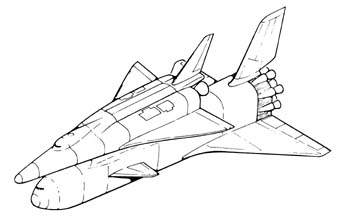
Figure 1. Fully-reusable shuttle concept. North American Rockwell c. 1970.
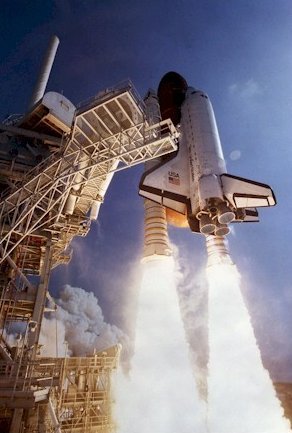
Figure 2. Space Shuttle launch.
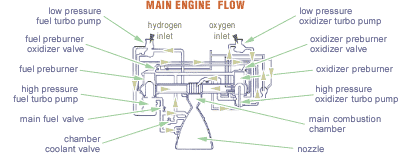
Figure 3. SSME schematic.
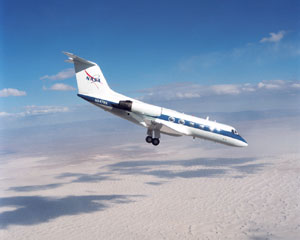
Figure 4. NASA Gulfstream Shuttle Training Aircraft.
The Space Shuttle was the core vehicle in NASA's space transportation system program and the only American craft used to carry humans into space since the Apollo-Soyuz Test Project. The Space Shuttle fleet was grounded following the loss of Challenger on 28 January 1986, and again after the destruction of Columbia during reentry on 1 February 2003. It briefly returned to flight in Jul 2005, but was grounded once again when debris was seen falling from the External Tank – the problem that precipitated the loss of Columbia. NASA successfully resumed Shuttle flights in 2006. The Shuttle program was retired in July 2011 following completion of the International Space Station (ISS). A new generation of much smaller, reusable vehicles will eventually replace it.
Each Space Shuttle consisted of an Orbiter , an External Tank (ET), two Solid Rocket Boosters (SRBs), and the Space Shuttle Main Engines (SSMEs). All these components (see below for details) were reusable except for the External Tank. Designed to operate on land, in the atmosphere, and in space, the Shuttle combined features of a rocket, an aircraft, and a glider. No other flying machine launched, served as a crew habitat and cargo carrier, maneuvered in orbit, then returned from space for an unpowered landing on a runway, and was ready to fly again within a few weeks or months. Its main engines and solid rocket motors were the first ever designed for use on multiple missions.
The Space Shuttle could take up to eight astronauts into low Earth orbit to carry out a wide variety of tasks, from satellite-launching to construction of the International Space Station, on missions last up to two and a half weeks. It was used to support research in astronomy, biology, space medicine, and materials processing, and delivered into orbit scientific, commercial, and military satellites and interplanetary probes. The Shuttle was also used to carry Spacelab and to repair, refurbish, and recover satellites. After the first launch on 12 April 1981 – 20 years to the day after Yuri Gagarin's historic flight – Shuttles flew two to nine missions a year, except in 1986 and 1987 when flights were suspended following the Challenger disaster. Although its cost proved to be much greater and its practical launch frequency much lower than originally anticipated, it did represent a giant leap forward in manned spaceflight capability.
The Shuttle traveled from the Vehicle Assembly Building at Kennedy Space Center (KSC), where its main components were put together, to its launch pad on a giant crawler-transporter vehicle – a trip which, at a maximum speed of 1.6 km/h, took about five hours. Launch complexes 39A and 39B at Cape Canaveral were originally used for the Apollo missions and renovated for the Shuttle. A third intended Shuttle launch site built at Vandenberg Air Force Base, California by renovating Titan III launch complex SLC-6 (nicknamed "Slick-6") was never employed.
History
Born in 1968 at the height of the Apollo program, the Shuttle was designed to provide NASA with an efficient, reusable method of carrying astronauts to and from a large, permanently manned space station (with a crew of 12–24), and a multipurpose satellite launch system with the potential to replace Atlas-Centaur, Delta, and Titan rockets. Originally slated to enter service by 1977, the Shuttle made its first spaceflight in 1981 following numerous design changes.
At the outset, NASA envisaged a two-stage Shuttle with a smaller manned winged vehicle (the Orbiter) riding piggyback on a larger manned winged vehicle (the Booster). These would be pad-launched from a vertical position. The Booster would carry the Orbiter to a height of about 80 kilometers, at which point the Orbiter would separate and fire its own engines to reach orbit. The Booster – essentially a winged fuel tank – would immediately descend and land near the launch site, while the Orbiter would return at the end of its mission. As described by NASA in 1970, this two-stage Shuttle would be able to carry a 11,300-kilogram payload to a maximum 480-kilometer circular orbit (Figure 2).
In a time of recession, it soon became clear that NASA could not afford a fleet of complicated two-stage Shuttles together with a space station. Furthermore, although military funding for the Shuttle was vital, the Air Force specified a payload capability nearly three times what NASA had in mind. These factors led to a dramatic redesign of both the Shuttle and the proposed space station. From a Skylab-like, single-structure station to be launched by a Saturn V and serviced by the Shuttle, NASA switched to a modular concept: the space station would be built over several years from separate, Shuttle-launched elements. This not only spread the financial outlay over a longer period, it meant that the more powerful Shuttle required would be able to carry heavy military payloads. The redesign would also allow NASA to secure private funding to carry commercial satellites aboard Shuttles while cutting costs by phasing out the Atlas, Delta, and Titan fleets. With an event like the Challenger disaster never anticipated, NASA put all of its eggs in one basket: the Shuttle would become the Agency's sole medium-to-heavy launcher into the next century. To cut costs further, NASA opted for a more traditional expendable system to carry the Orbiter into space, involving drop-away boosters and an expendable main engine fuel tank.
Rockwell began work on Orbiter Enterprise, officially known as Orbiter Vehicle-101 (OV-101), in June 1974. This was first rolled out of its hangar at Palmdale, California, on 17 September 1976, and subsequently used for flight testing at the Dryden Flight Research Center. Meanwhile Rockwell continued to develop Orbiters Columbia (OV-102), Discovery (OV-103), and Atlantis (OV-104). Although Enterprise was originally intended to be refitted as an operational Shuttle, NASA opted instead to upgrade Challenger (OV-099) from its status as a high-fidelity structural test article. Upon the loss of Challenger in January 1986, it was decided to build a fifth operational Shuttle, Endeavour (OV-105), as a replacement.
The initial concept of flying 25–60 missions per year never proved realistic, and by the mid-1980s NASA was gearing toward a more modest launch rate of about 24 missions per year. Then the entire program was ground to a halt when, on 28 January 1986, the 25th Shuttle mission ended tragically little more than a minute after takeoff. The explosion of Challenger made it stunningly clear that major changes in the entire Shuttle program were unavoidable. With the launch of Discovery on 29 September 1988, NASA entered a new era of Shuttle operations, adopting a more relaxed pace averaging about eight launches per year. Learning from one of its greatest tragedies, NASA was able to rebuild and maintain a Shuttle program that had an outstanding setback – until the further setback of Columbia's loss. In April 1996 NASA began a four-phase plan, known as the Space Shuttle upgrade program, to keep the existing Shuttle fleet flying through at least 2012 and also proposed modifications and upgrades that might keep the fleet in action through 2030. Phase one of the plan called for improvements to the Shuttle to allow it to support construction and maintenance of the International Space Station – the program's chief goal well into the 21st century. Phase two called for operational and cost improvements in ground operations that would decrease Shuttle servicing and maintenance time in order to support an average of 15 launches per year. Phase Three called for a number of modifications to Orbiter onboard systems that would also result in decreased processing and maintenance time. More ambitious elements of this plan envisaged the complete replacement of toxic fuels by nontoxic fuels in key Orbiter systems. Phase four called for significant redesign of the Shuttle fleet and its basic configuration.
External Tank (ET)
The propellant tank for the Space Shuttle Main Engines (SSMEs). It was the largest and only non-reusable element of the Shuttle and provided a structural backbone for the entire system. Each ET contained a liquid oxygen (LOX) tank at the top and a liquid hydrogen (LH2) tank at the bottom which were connected by an intertank, 6.9 meters long by 8.4 meters wide. The ET supplied LOX and LH2 to the Orbiter's three SSMEs through 43-centimeter-diameter feed lines: LOX at a rate of 72,300 kilograms (63,600 liters) per min, LH2 at 12,100 kilograms (171,400 liters) per minute. At launch, the ET was attached to both the Orbiter and SRBs. It emptied about 8.5 min after launch, at which time it was jettisoned, broke up, and fell into a predetermined area of either the Pacific or Indian Ocean.
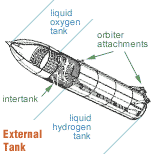 |
The first six ETs delivered to NASA were called standard weight tanks (SWTs), each weighing 34,250 kilograms. SWTs were flown on missions STS-1 through STS-5 and STS-7. For STS-1 and STS-2, the ETs were painted white. Thereafter, hundreds of kg and thousands of dollars in preparation work were saved by leaving ETs unpainted, so that all ETs flown from STS-3 on sported an orange-brown color. In 1979, even before a Shuttle had completed a spaceflight, NASA directed that ETs be lightened so that heavier payloads could be flown. The resulting ET, called the Lightweight Tank (LWT), shaved 4,500 kilograms off the SWT by using new materials and design changes. The 29,700-kilograms LWT was first flown on STS-6, and then from STS-8 through STS-90. Starting with STS-91, a new ET called the super lightweight tank (SLWT) was flown. Weighing 26,300 kilograms, it enabled still heavier payloads to be carried in support of the International Space Station.
| External Tank (SLWT version) stats | |
|---|---|
| length | 46.9 m |
| diameter | 8.4 m |
| mass | 757,000 kg (total); 730,000 (propellant) |
| LOX tank | |
| size | 16.6 × 8.4 m |
| capacity | 549,000 liters |
| LOX mass | 626,000 kg |
| LH2 tank | |
| size | 29.5 × 8.4 m |
| capacity | 1,470,000 liters |
| LH2 mass | 104,000 kg |
Orbiter
A wide-body, delta-winged airplane and space vehicle, built mainly of aluminum and covered with reusable surface insulation (see reentry thermal protection). It was propelled by three Main Engines and 46 smaller rocket engines in various combinations for liftoff, attitude control in space, and initiating reentry. The Orbiter could carry up to eight crew, including a mandatory commander and pilot, and deploy and/or retrieve payloads utilizing a 18.3 × 4.57 meters cargo bay. An array of standard payload platforms, including the European Spacelab or commercial Spacehab modules, were carried into space and returned to Earth at the end of a mission. An articulated arm called the Remote Manipulator System (RMS), could be operated by Shuttle astronauts from inside the cabin and used to manipulate payloads out of or into the payload bay.
The crew module was an independent, pressurized vessel of welded aluminum suspended within the forward fuselage of the Orbiter; it had two hatches and 10 windows, and consisted of a two-level flight deck and crew quarters. During launch up to four astronauts could sit on the upper flight deck and up to four more on the middle crew quarters deck. The forward portion of the flight deck resembled the cockpit of a jet airliner but featured separate controls for flying in space and flying in the atmosphere. The aft portion of the flight deck contained four stand-up duty stations including the controls for the RMS. The crew quarters deck was entered through an open hatch in the flight deck floor and provided eating, sleeping, and sanitary facilities. At the aft end of the crew quarters deck was an air lock, through which astronauts could enter the cargo bay for extravehicular activities. Electrical power for Orbiter systems was provided by fuel cells which produced, as a byproduct, water for drinking.
| Orbiter statistics | |
|---|---|
| wingspan | 23.79 m |
| length | 37.24 m |
| height | 17.27 m |
| habitable volume | 71.5 cubic m |
| dry mass | 78,448 kg (OV-102: 82,288 kg) |
| landing mass | 104,328 kg max |
| payload (to 204-km LEO) | 24,990 kg (OV-102: 21,140 kg) |
Solid Rocket Boosters (SRBs)
Twin solid propellant motors that provided just over 70% of the thrust needed to launch the Space Shuttle. They were the largest such motors ever built, and the first designed to be reused. The SRBs also supported the entire weight of the Orbiter and ET prior to launch.
Each SRB was attached to the ET at the SRB's aft frame by two lateral braces and a diagonal attachment. The forward end of each SRB was attached to the ET at the forward end of the SRBs forward skirt. On the launch pad, each SRB was fastened to the mobile launcher platform (MLP) at the SRB aft skirt by four large bolts that were severed by explosive charges at liftoff.
The propellant was a mixture of 69.6% ammonium perchlorate oxidizer, 16% aluminum (fuel), 0.4% iron oxide catalyst, 12.04% polymer binder, and 1.96% epoxy curing agent. This was contained within the SRB beginning with an 11-point star-shaped perforation in the forward segment to a double-truncated cone perforation in both of the aft segments and the aft closure segment. These varying shapes allowed the SRB thrust to be reduced 50 seconds after launch by about 33% to relieve stress on the Shuttle as it went through maximum dynamic pressure. The SRBs were ignited by electronic command from the orbiter at launch minus zero, provided that the Shuttle main engines (SSME) had built up enough thrust to support a launch. The SSMEs were ignited first, since the SRBs could not be shut down once they had been ignited and it would be catastrophic if the SRBs had been ignited after an SSME failure on the launch pad. Each SRB exhaust nozzle couldbe gimbaled up to 8° to help steer the Shuttle during ascent.
About 125 seconds after launch, at an altitude of about 45,000 meters, the SRBs burnt out and were jettisoned. The jettison command came from the Orbiter, and jettison occured when the forward and aft attach points between the SRBs and ET were blown by explosive charges. Milliseconds after SRB separation, 16 solid-fueled separation motors, four in the forward section and four in the aft skirt of each SRB, were fired briefly to help carry the SRBs away from the rest of the Shuttle. About 225 seconds after separation, at an altitude of 4,800 meters, the nose cap of each SRB was ejected and a pilot parachute deployed. This served to pull out the 16.5-meter-diameter drogue parachute which oriented and stabilized the descent of each SRB to a tail-first attitude ready for deployment of the main parachutes. At an altitude of 1,800 meters, the three 41-meter-diameter main parachutes opened to slow each SRB to water impact at about 25 meters per second. The SRBs splashed down in the Atlantic about 225 kilometers from the launch site. Retrieval ships located each SRB by homing in on radio beacon signals transmitted from each booster and by flashing lights activated on each SRB. Once on location, recovery crews plugged the SRB nozzles, emptied the motors of water, and towed the rockets back to a receiving and processing site on Cape Canaveral. After inspection, the SRBs were disassembled, washed with fresh, deionized water to limit saltwater corrosion, and refurbished ready to fly.
| SRB statistics | |
|---|---|
| length | 45.5 m |
| diameter | 3.7 m |
| mass (per SRB) | 585,000 kg (with fuel); 85,000 kg (empty) |
| thrust (per SRB) | 14.7 million N |
Space Shuttle Main Engines (SSMEs)
The most advanced liquid-fueled rocket engines ever built. Each SSME generated enough thrust to maintain the flight of 2.5 Boeing 747 jumbo jets, and was designed for 7.5 hours of operation over an average lifespan of 55 starts. Each Orbiter had three SSMEs mounted on its aft fuselage in a triangular pattern.
 |
The Main Engines burned a combination of liquid oxygen and liquid hydrogen fed from the ET and employed a staged combustion cycle, in which the fuels were first partially burned at high pressure and low temperature, then burned completely at high pressure and high temperature. This allowed the SSMEs to produce thrust more efficiently than other rocket engines. SSME thrust could be varied from 65% to 109% of rated power at increments of 1%. A thrust value of 104%, known as full power, was typically used as the Shuttle ascended, although, in an emergency, each SSME could be throttled up to 109% power. All three SSMEs received identical and simultaneous throttle commands which usually came from general purpose computers aboard the Orbiter.
Firing of the three SSMEs began at launch minus 6.6 seconds, at which time general-purpose computers aboard the orbiter commanded a staggered start of each SSME. The first to fire was main engine number three (right), followed by number two (left) and number one (center) at intervals of 120 milliseconds. If all three SSMEs did not reach at least 90% thrust over the next 3 seconds, a main engine cutoff (MECO) command would be issued automatically, followed by cutoff of all three SSMEs. If all SSMEs were performing normally, the Shuttle could be launched.
The SSMEs achieved full power at launch, but were throttled back at about launch plus 26 seconds to protect the Shuttle from aerodynamic stress and excessive heating. They were throttled back up to full power at about Launch Plus 60 seconds and typically continued to produce full power for about 8.5 minutes until shortly before the Shuttle entered orbit. During ascent, each SSME could be gimbaled plus or minus 10.5° in pitch and yaw to help steer the Shuttle. At about launch plus 7 minutes 40 seconds the SSMEs were throttled down to avoid subjecting the Shuttle and crew to gravitational forces over 3g. At about 10 seconds before main engine cutoff, a MECO sequence began. About 3 seonds. later, the SSMEs were commanded to begin throttling back at intervals of 10% thrust per second until they reached a thrust of 65% of rated power, called minimum power. This power was maintained for just under 7 seconds, then the SSMEs shut down.
| SSME statistics | |
|---|---|
| length | 4.3 m |
| diameter | 2.3 m |
| rated thrust (per SSME) | 1,670,000 N |
Mission and payload specialists
A mission specialist was a Space Shuttle astronaut whose responsibilities could include conducting experiments in orbit, construction of the International Space Station, and control of the Orbiter's resources to a payload. Mission specialists were professional astronauts, employed by NASA or other space agencies, as distinct from payload specialists.
Gulfstream Shuttle Training Aircraft
To train Space Shuttle pilots in landing the vehicle, prior to making their first spaceflight, NASA used a modified Gulfstream 2 executive jet (Figure 4). The cockpit was divided into two – with Shuttle controls on the left, and normal Gulfstream controls on the right. The flight dynamics of the Shuttle were calculated before the Shuttle actually flew, and the Gulfstream 2 trainer modified accordingly. The calculations proved to be so accurate that very few changes were made after the Shuttle entered service.
Future
Designed in the 1970s and first flown in 1981, the Shuttle was envisioned as a workhorse vehicle that would make space travel commonplace. Nearly a quarter-century later, after two deadly accidents that have killed 14 crew, NASA described the Shuttle as a test vessel whose useful days are numbered. In their final years of operation, the remaining three-ship (Atlantis, Discovery, and Endeavour) completed construction of the International Space Station, satisfying US commitments to the space agencies of Europe, Russia, Japan and Canada.
The Shuttle's replacement was to have been the Ares I and V launch vehicles and an Apollo-like Orion spacecraft (Crew Exploration Vehicle), scheduled to make its first test flight in 2012. Orion was to have been developed to support NASA's ambitious goal to return Americans to the Moon by 2020 and send them eventually to Mars. However, the Constellation program, of which Orion was part, was cancelled. The current plan is for NASA to work in partnership with aerospace companies to develop a much smaller vehicle to carry astronauts and supplies to the ISS, and perform other tasks in low Earth orbit. NASA has also signed an agreement with United Launch Alliance to assess what is need to upgrade the Atlas V to carry a crewed spacecraft.



